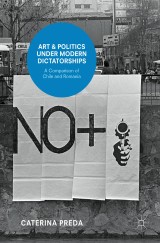Details

Art and Politics under Modern Dictatorships
A Comparison of Chile and Romania|
90,94 € |
|
| Verlag: | Palgrave Macmillan |
| Format: | |
| Veröffentl.: | 19.07.2017 |
| ISBN/EAN: | 9783319572703 |
| Sprache: | englisch |
Dieses eBook enthält ein Wasserzeichen.
Beschreibungen
This book analyzes the relationship between art and politics in two contrasting modern dictatorships. Through a detailed look at the Chilean and Romanian dictatorships, it compares the different ways in which political regimes convey their view of the world through artistic means. It examines how artists help \ convey a new understanding of politics and political action during repressive regimes that are inspired by either communism or anti-communism (neoliberalism, traditionalist, conservative). This book demonstrates how artistic renderings of life during dictatorships are similar in more than one respect, and how art can help better grasp the similarities of these regimes. It reveals how dictatorships use art to symbolically construct their power, which artists can consolidate by lending their support, or deconstruct through different forms of artistic resistance.
1. Art and Politics under Modern Dictatorships: An Introduction<div><br></div><div>2. The Two Modern Dictatorships in Chile and Romania 1970s-1989</div><div><br></div><div>3. Art Should Be Apolitical: Official Art in Chile </div><div><br></div><div>4. Art Must Be Politicized: Official Art in Romania </div><div><br></div><div>5. Alternative Art in Chile: Politicized Art</div><div><br></div><div>6. Alternative Art in Romania: Aesthetic Resistance </div><div><br></div><div>7. A Model of Comparative Analysis of Art and Politics in Dictatorships</div>
<div><b>Caterina Preda</b> is Senior University Lecturer at the Department of Political Science, University of Bucharest, Romania. </div><div><br></div>
This book analyzes the relationship between art and politics in two contrasting modern dictatorships. Through a detailed look at the Chilean and Romanian dictatorships, it compares the different ways in which political regimes convey their view of the world through artistic means. It examines how artists help \ convey a new understanding of politics and political action during repressive regimes that are inspired by either communism or anti-communism (neoliberalism, traditionalist, conservative). This book demonstrates how artistic renderings of life during dictatorships are similar in more than one respect, and how art can help better grasp the similarities of these regimes. It reveals how dictatorships use art to symbolically construct their power, which artists can consolidate by lending their support, or deconstruct through different forms of artistic resistance.
<p>Enriches the reader's understanding of the way art and politics function in a dictatorship</p><p>Explores the neglected topic of art under non-democratic regimes</p><p>Presents a comparative analysis of the interaction between art and politics in two dissimilar dictatorships</p><p>Uses an interdisciplinary approach that combines the fields of political theory, theory of art, art history, and contemporary philosophy</p><p>Includes supplementary material: sn.pub/extras</p><p>Includes supplementary material: sn.pub/extras</p>
“Did art and politics interact differently in the right-wing military juntas of Latin America and the left-wing communist regimes of Central and Eastern Europe of the late 20th century? Caterina Preda answers this question by comparing the ways in which art and artists were treated in Chile under Augusto Pinochet and Romania under Nicolae Ceaușescu. This compelling analysis, which rests on a wealth of information and first-rate familiarity with both countries, has a lot to offer to a wide readership.” (Lavinia Stan, Chair, Department of Political Science, St. Francis Xavier University Nova Scotia, Canada) <p>“In a comparison of the cultural policies of two polar opposite dictatorships, Caterina Preda highlights in an intriguing manner the main goal of any authoritarian regime: subjecting society and individuals to an all-encompassing order. While the Pinochet dictatorship spawned a politicized art and a culture of opposition, although it has advocated a de-politicized art and culture, in the case of Ceaușescu, a dictatorship desiring a politicized art managed to create a culture of artistic dissidence.” (Renée Fregosi, Research Director in Political Science, University Paris Sorbonne-Nouvelle, France)</p>
Diese Produkte könnten Sie auch interessieren:

How Insights from Moral Psychology and Character Research can aid Development Cooperation

von: Jan Prothmann

13,99 €















